.
Chief Curator Robert Leonard introduces the new show, Zac Langdon-Pole: Containing Multitudes.
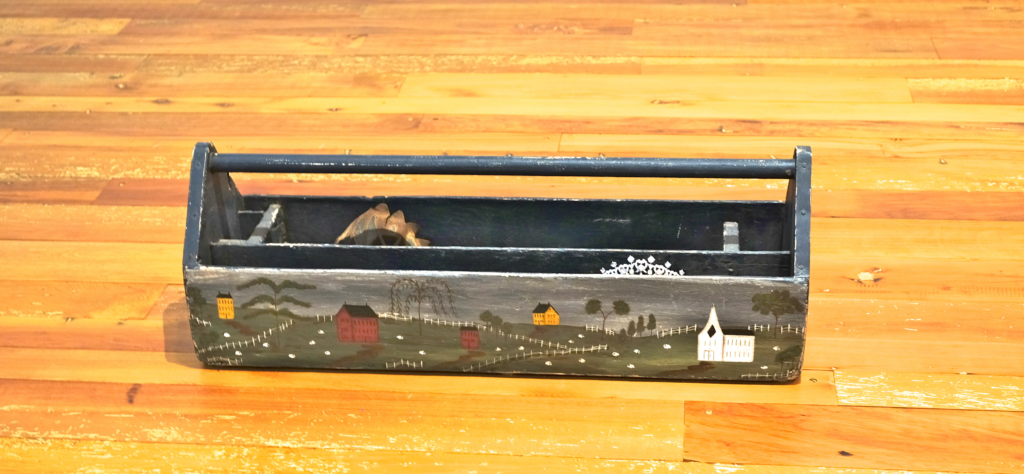
1
Someone has left a wooden toolbox on the gallery floor. It contains two items: a replica royalist tiara (a classy bauble) and a rusty old calf weaner (used down on the farm to separate cows from their calves, preventing suckling). These items make odd bedfellows, being radically opposed in purpose and aesthetic (nice and nasty, high and low, decorative and pragmatic) yet related (both attach to heads and are similar in shape). What are they doing together here? Whose toolbox is this?
The work’s title Emic Etic refers to contrasting methodologies in anthropology: emic stressing the cultural perspective of the subject, etic that of the observer. The title prompts us to imagine that there might be two ways of approaching this work, as an insider and as an outsider. But whose are these perspectives? Should we view the weaner from the viewpoint of the tiara or the tiara from the viewpoint of the weaner—or both from that of the toolbox? Should we privilege the perspective of calf or Queen (or someone fantasising they’re one or the other) or the perspective of the owner of the toolbox (whoever they might be)? Should we approach the task of interpretation like some proverbial Martian or imagine that it’s already a Martian’s toolbox? Should we take a local perspective and assume the work is about how New Zealand was weaned from the motherland after Britain joined the EEC in 1973 and stopped favouring our meat and cheese—or is that taking the metaphor a bit too far?
Perhaps there’s a wall text to explain it, to quell the disorienting proliferation of interpretive options. Perhaps not.
2
Emic Etic is a work by Zac Langdon-Pole, a young New Zealand artist based in Berlin. Sometimes it’s hard to judge whether his works are straight or absurd, philosophical or pataphysical—whether they make sense or unmake it. They do foster a certain quality of attention—inquiring and open, sensitive and poetic.
Since graduating with a master’s degree from Frankfurt’s Städelschule art school in 2015, Langdon-Pole has gone on to great things, exhibiting widely—and travelling. He was one of the winners of the 2017–8 Ars Viva prize, which took him to a residency on remote Fogo Island in Newfoundland, Canada. In 2018, he won the seventh BMW Art Journey. It enabled him to conduct an extensive trip through Europe and the Pacific—following an itinerary based on the routes of migrating birds—to explore celestial-navigation systems used by Pacific peoples and their colonisers. Such opportunities have fed his immense curiosity.
In February 2020, the frequent flyer was back home for Interbeing, his sixth show at Michael Lett, his Auckland gallery, with works made as a result of the BMW trip. They included photograms of sprinkled sand that looked like views of deep space, anatomical models collaged with exotic flora and fauna, and a meteorite fragment hiding in a children’s educational game. When Covid-19 hit in March, the artist found himself stuck here with borders closed and European gigs cancelled. He took the opportunity of this enforced stay to develop a show for City Gallery, combining works from Interbeing, earlier projects, and new works made especially for the show. The new works include a native-timber floor with gilded borer holes, a bowl pieced together from diverse fragments, collaged jigsaw puzzles, and a montage of film clips depicting an unpeopled New Zealand landscape.
Containing Multitudes is Langdon-Pole’s largest show to date and it’s a variety show. Works take myriad forms, operate in different registers, address diverse topics, and imply multiple frames of reference—from ancient to recent, macro to micro, and scientific to romantic. The show offers more dots to connect, more lines of thought to pursue, more links, more digressions. The artist wants to stretch us, challenging us to encompass this abundance. It’s an opportunity to get our heads across his project or lose ourselves trying.
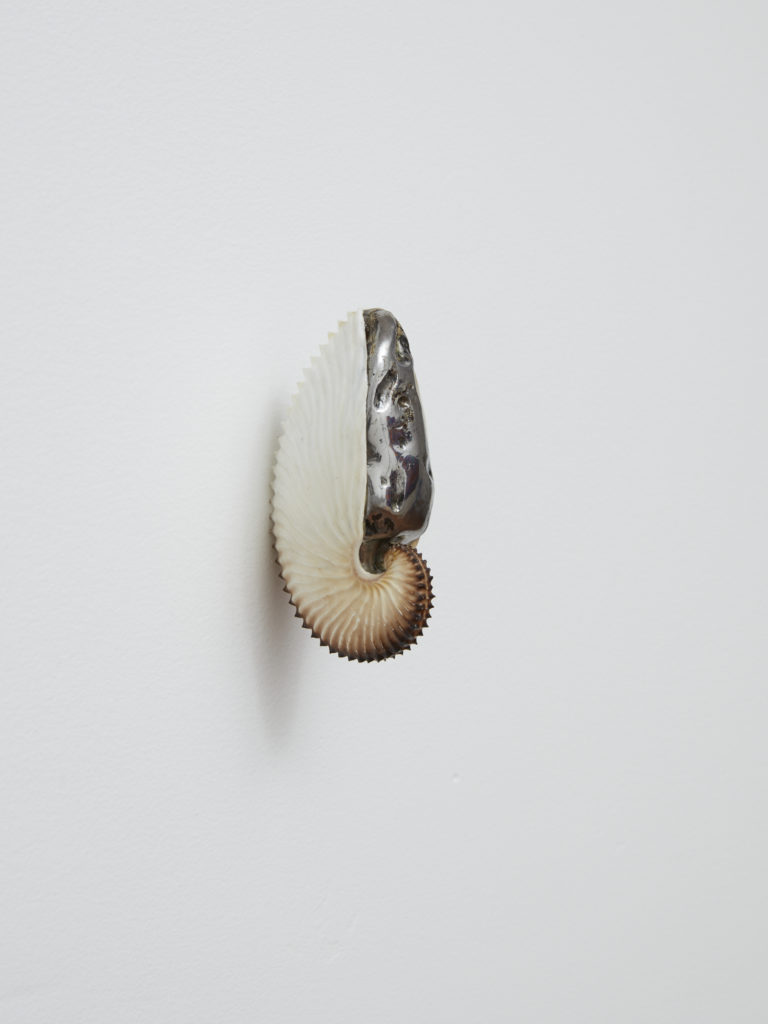
3
Many of Langdon-Pole’s works are collages or assemblages of found materials. In his series Passport (Argonauta), he places carved meteorite fragments into the mouths of paper-nautilus shells. Juxtaposing robust and fragile, mineral and animal, the extraterrestrial and the submarine, these juxtapositions stop us in our tracks, aesthetically and conceptually. They exemplify the surrealist ‘marvellous’, recalling Lautréamont’s chance encounter of an umbrella and a sewing machine on an operating table. We can only wonder what might emerge from such charged couplings.
Langdon-Pole’s collages and assemblages often feel speculative, like he’s trying keys in locks, looking for a fit. Throughout his work, speculative physical operations stand in for speculative conceptual ones. But, when he physically links and aligns things, it isn’t always clear if he has uncovered deeper connections or generated non sequiturs. He leaves that question hanging, letting us make of his arrangements what we will.
Consider his ‘Frankenstein’ bowl, which combines bowl fragments from ancient Greece and Rome, from Islamic empires of the middle ages, and from eighteenth-century Britain. He sourced the pieces via eBay and stapled them together—perhaps provisionally. The bowl looks like it could have been assembled by a someone attending to shapes, oblivious to appearances. Perhaps the bowls are a metaphor for historical inquiry itself—our desire to imagine wholes from traces.
The title, Translatio Studii (No Such Thing as Western Civilisation), refers to a fallacy—the idea of a discrete, linear, pure ‘Western tradition’. In reality, much classical knowledge was lost during the Middle Ages in Europe and could only be rediscovered in the Renaissance because it had been preserved in libraries in the East, sometimes translated into Arabic. But is the artist implying that the ‘whole bowl’ (this Western tradition) is actually hybrid? Is he pointing to a historical, causal connection between the pottery practices in various times and places? Or, is he demonstrating the universality of the bowl as a form and of ceramic as a material?
Langdon-Pole’s video Breath as Breath as Breath does something similar by splicing together diverse film fragments. It’s a montage of sequences depicting a New Zealand landscape void of human presence taken from old cel-animation films made in different styles and for different purposes (including children’s cartoons, educational films, and a party-political ad). In the original films, ‘nature’ was sometimes the subject, sometimes incidental. The montage, however, consistently thrusts non-human life—plant and animal, real and imagined—into the foreground, inviting us to critically reflect on the idea of ‘natural’ New Zealand and its place in our collective cultural unconscious.
Langdon-Pole’s editing provides some continuity, as does an atmospheric soundtrack by composer Samuel Holloway. Nevertheless, a monstrous ‘Frankenstein’ quality persists, which keeps us speculating on the roles the excerpts played in the original works. Breath as Breath as Breath is like a sequence of establishing shots, prompting us to expect the arrival of human protagonists, who never come. And yet, as much as it depicts an unpeopled nature, its diverse hand-drawn styles mark its components as always-already cultured—invested with person-ality. It raises the question: is it possible for people to even imagine a world without people?

4
As Langdon-Pole treats things in the world like jigsaw-puzzle pieces waiting to be put together, it’s no surprise that jigsaw puzzles have inspired a huge new body of work. Learning that puzzle makers use the same templates to cut different images, he realised he could create surrealist-style collages by substituting pieces from two different puzzles. The puzzles he uses mostly reproduce old-master paintings and encyclopaedia-plate illustrations. The works combine on two levels: not only do the jigsaw pieces fit together, the original images themselves fuse suggestively, uncannily. Titles add a further prompt and twist.
Pollinations, for instance, mashes genres, combining Pieter Bruegel the Elder’s famous painting of the Tower of Babel (c.1563) and a blooming floral still life by Jan Frans van Dael (1792). The Breugel refers to an account in Genesis purporting toexplain the diversity of human languages. After the Great Flood, a united human race supposedly spoke a single language. But, when they decided to build a skyscraper tall enough to approach heaven, God confounded their speech so that they could no longer understand one another and scattered them around the globe, such that they might never again attempt a similar feat. In a Magrittian manoeuvre, Langdon-Pole switches out Bruegel’s ziggurat for Van Dael’s mixed posy. It works visually, but the upshot remains ambiguous. Do the flowers suggest the blooming of multiple human cultures, or have they grown over the ruined tower, with nature triumphing over culture? Someone may have solved the puzzle by putting the pieces together, but not necessarily the riddle that underpins it. Indeed, solving the puzzle only reveals its riddle.
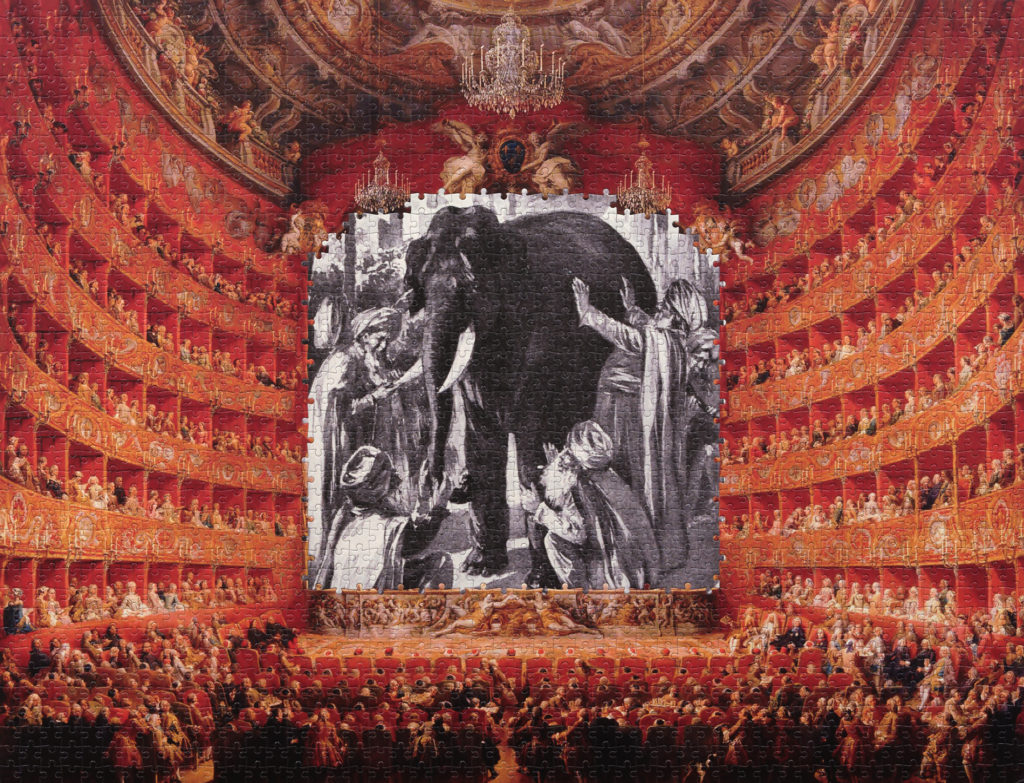
5
Langdon-Pole’s works can be perplexing. Not only do we interpret them, they make us think about interpretation, about how we make sense of things. They’re meta.
His works frequently address erroneous ideas that once passed for fact. Several works refer to the brightly coloured bird of paradise. In the sixteenth century, New Guineans traded the birds’ skins—after removing their legs—with visiting Europeans. It prompted the misconception among European naturalists that the birds were born in the air and flew without rest, until dropping dead to earth. For Tomb(e), Langdon-Pole presents a legless, preserved bird of paradise in a mirror-lined interior in a old safe, recalling the bird’s role as a trade currency between worlds. Another room is wallpapered with a pattern based on a blueprint photogram of its missing legs.
One of Langdon-Pole’s jigsaws makes error its explicit subject. The main image—Giovanni Paolo Panini’s painting Musical Fête (1747)—shows a packed opera house, whose audience attends to the sumptuous illusion being staged for them. However, Langdon-Pole has replaced that attraction with a dour black-and-white illustration of an old Indian parable. It concerns a group of blind men who chance upon an elephant—something they’ve never encountered before. Each man grabs a different part of the beast—trunk, tusk, side, leg, and tail—and proceeds to describe the whole beast based on their partial experience. As their descriptions are so divergent, they end up in a dispute. No one grasps the whole.
The lesson, of course, is that we are all ‘blind’, with a tendency to claim absolute truth based on our limited perceptions. This is equally true of the blind men, the theatre goers fixed in their seats, the person who assembled the puzzle, and those in the gallery looking at it. It’s a mise en abyme. Hence Langdon-Pole’s title, Two-Thousand-and-One Elephants.
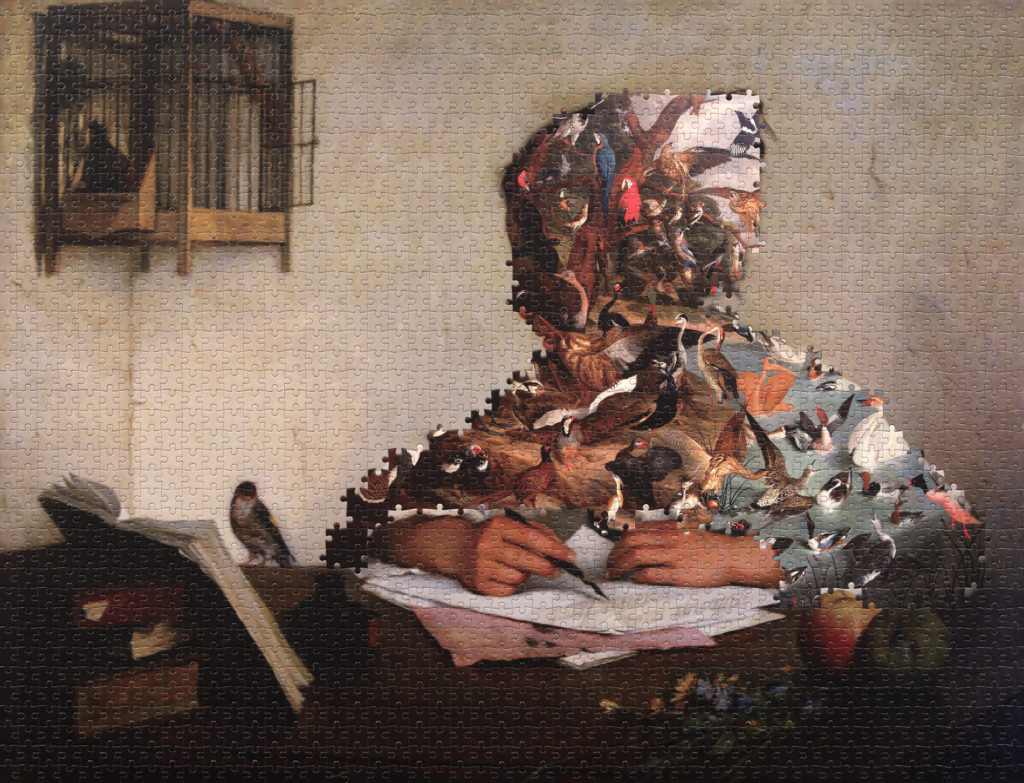
6
While he knows we have limited access to the world, Langdon-Pole also believes we can be attuned to its richness. His show title Containing Multitudes is a nod to the nineteenth-century American poet Walt Whitman’s ‘Song of Myself’ from Leaves of Grass:
Do I contradict myself?
Very well, then I contradict myself,
(I am large, I contain multitudes.)
In this poem, Whitman famously captures what it’s like to live in a body, energised by worldly sensations and earthy delights. He realises his body is the result of epic evolutionary changes and part of an endless, ongoing proliferation of forms of life. Langdon-Pole’s title emphasises the contradiction. It may be about ‘multitudes’ (the abundance of nature and culture) but it’s also about ‘containing’ (the imperative to stretch ourselves to encompass it).
Containing Multitudes is not only the title of the show, it’s also the title of one of the jigsaw works—itself a single image consisting of a plenitude of pieces. A key work for the show, it combines Henriette Browne’s charming painting A Girl Writing from around 1870 (which depicts a girl doing homework being distracted by a goldfinch that has escaped its cage) and Carl Wilhelm de Hamilton’s The Parliament of Birds from around1730 (a pre-Darwinian view of avian diversity). Langdon-Pole removed the jigsaw pieces of the child from Browne’s image and filled in her silhouette with pieces from De Hamilton’s, so that her singular outline literally contains multitudes.
If the one bird was already a metaphor for the girl, distracted, freed from the cage of her studies, it has somehow multiplied within her, as if, in looking at one bird, she can conjugate the many forms that birds might take. Containing Multitudes is an image of identification and interspecies empathy: the one dissolved in the many; the one ‘containing multitudes’. (Another jigsaw work makes a similar analogy between multiple bird forms and the structure of the human brain that apprehends them. Memory Tree (A B) entwines two illustrations: Henry Scherren’s Picarian Birds and Parrots and Santiago Ramón y Cajal’s Neurons from the Human Cerebellum, from 1885 and 1899 respectively.)
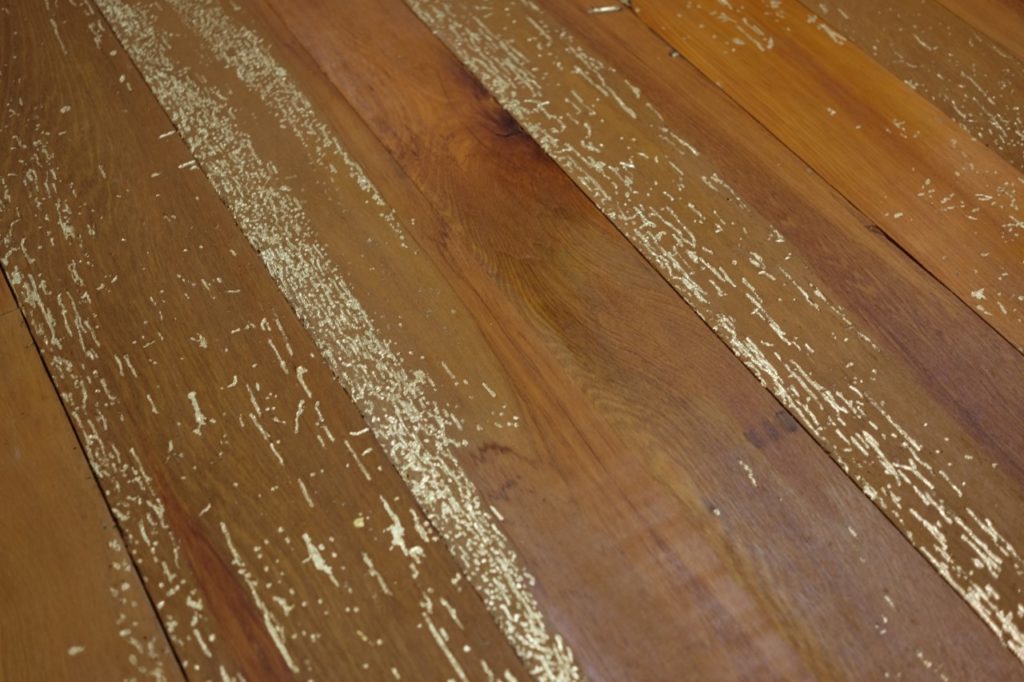
7
Langdon-Pole’s art is riddled with allegory. In allegories, levels of meaning—concrete and abstract, literal and symbolic—coexist, often in tension. Metaphors may be poetic, opening up our understanding of things, but they are also limited. They depend on our appreciating what is salient and what is superfluous in them. But Langdon-Pole loves mixing his metaphors, perhaps to take us further into his subjects, perhaps to further expose our mindsets.
For his installation Punctatum (Library), Langdon-Pole has refloored City Gallery’s North Gallery with recycled once-borer-ridden native timber. The borer holes and tracks have been patiently filled with resin and gilded, recalling the Japanese art of kintsugi, where broken ceramics are glued back together and the cracks picked out in gold—damage becoming decor. It’s a perverse gesture, investing such care and expense in dressing spoilt timber.
In doing this, Langdon-Pole highlights the beetles’ colonisation of the timber as a consequence of and parallel to Pākehā colonisation of the country. But how far can we take this? Sure, early colonists brought the pests with them unknowingly, but the little critters were less agents of colonisation than of hubris, destroying the colonists’ own homes. Unlike the settlers, they knew nothing of borders and sovereignty, and struck and broke no treaties. As Pākehā walk across the floor and look down, we can understand our own passage across the land—across time and space—as something akin, and not. The borer beetles are us and not us. How far might we take the metaphor before it collapses and gives up the ghost?

8
With its random fossils, artefacts, and oddities, Containing Multitudes recalls a wunderkammer or ‘cabinet of curiosities’. In pre-modern times, these proto-museums were all the rage. They were heterogeneous displays of amazing stuff: skeletons, dried insects, taxidermy, art works, scientific instruments, ancient texts, you name it. They were fanciful—labelling narwhal tusks as unicorn horns. Their creators favoured the exceptional and esoteric over the typical and exemplary.
Wunderkammers were superseded with the Enlightenment, which introduced scientific method and systematic taxonomies—proper museology. However, these days, wunderkammers are back in fashion, perhaps because they seem to offer escape from the straitjackets of scientism, suggesting other possibilities. As much as Langdon-Pole wants to disorient us, upsetting apple carts of habitual thinking, he also wants to throw us back into the world’s fecundity, the midst of things, with newly expanded horizons, dilated brains, and enchantment.
Take his work, Assimilation Study. At first glance, it seems to be a set of painted wooden ‘shape sorter’ blocks, a toy to teach children how to discriminate between shapes. On closer inspection, we can see the ensemble has been infiltrated by a foreign agent: a chunk of a meteorite tooled to the exact dimensions of a wedge block. It fits into the set spatially, but stands out materially. The two frames of reference implied are so divergent: a humble children’s game of recent origin and a piece of a meteorite that flew through space for millions of years before humans existed, landed on Earth thousands of years ago, and only recently found its way into Langdon-Pole’s game. Has the block infiltrated the game? Has it been assimilated? Is it just passing through? The gesture seems to exceed puny human frames of reference.
Something similar is going on with other Langdon-Pole works. In Dust as Dust as Dust (All the Way Down), a sixty-million-year-old tortoise-shell fossil rests on a vacuum cleaner uncannily similar in shape. And there’s his sand photograms—banal, depthless, cameraless images recalling the sublimity of deep space, with the shadows left by tiny sand grains (that had once rested on the print’s surface) suggesting immense stars (light years away from it). They seem to illustrate William Blake’s immortal lines, ‘to see a world in a grain of sand’ and ‘hold infinity in the palm of your hand’. Are such connections error or insight, or could they be both?
Do I contradict myself? Very well, then I contradict myself, (I am large, I contain multitudes.)
